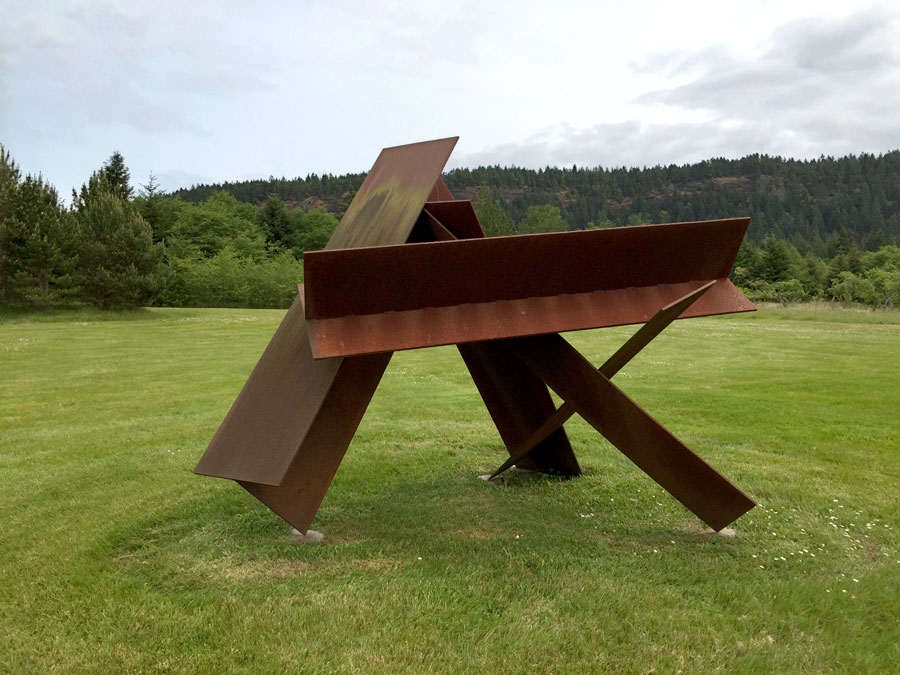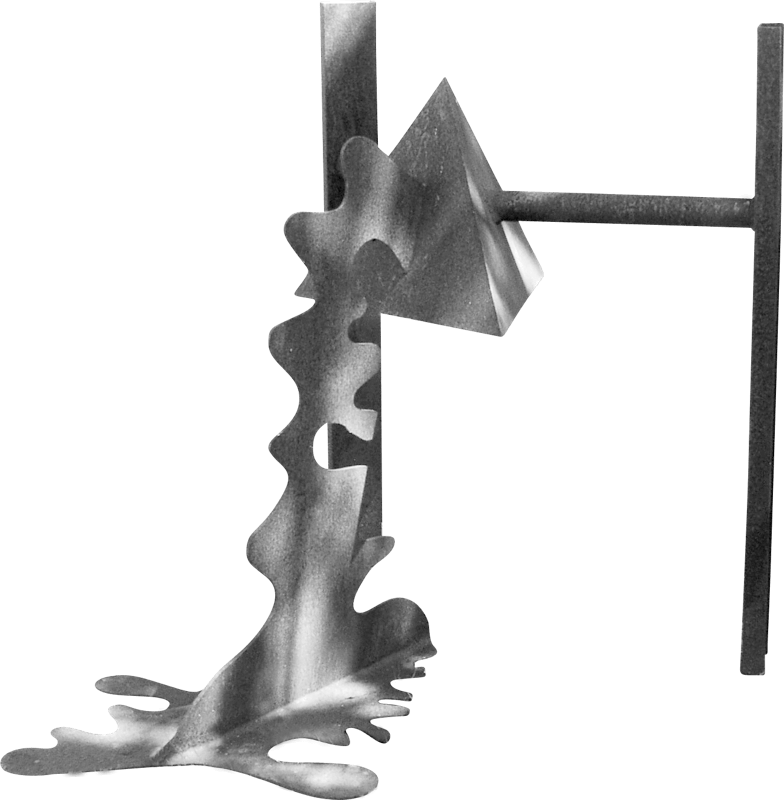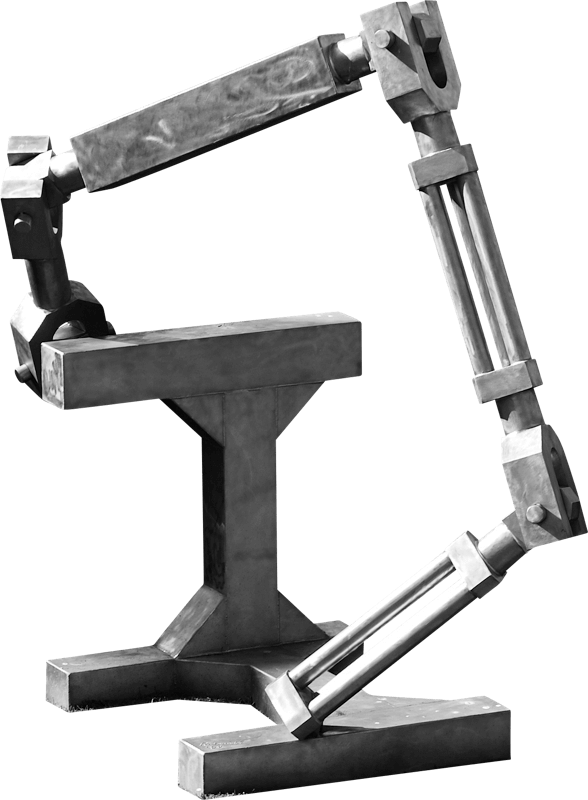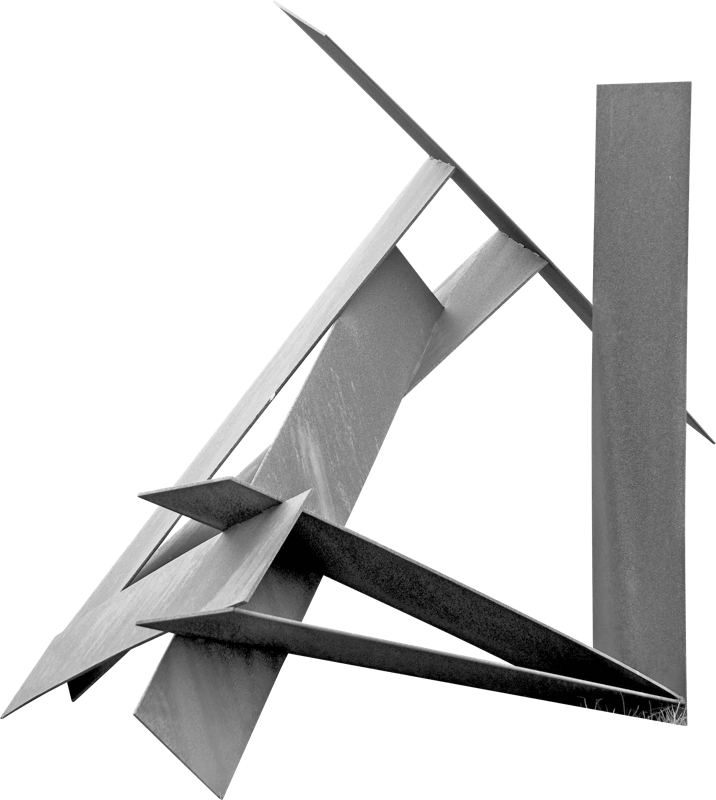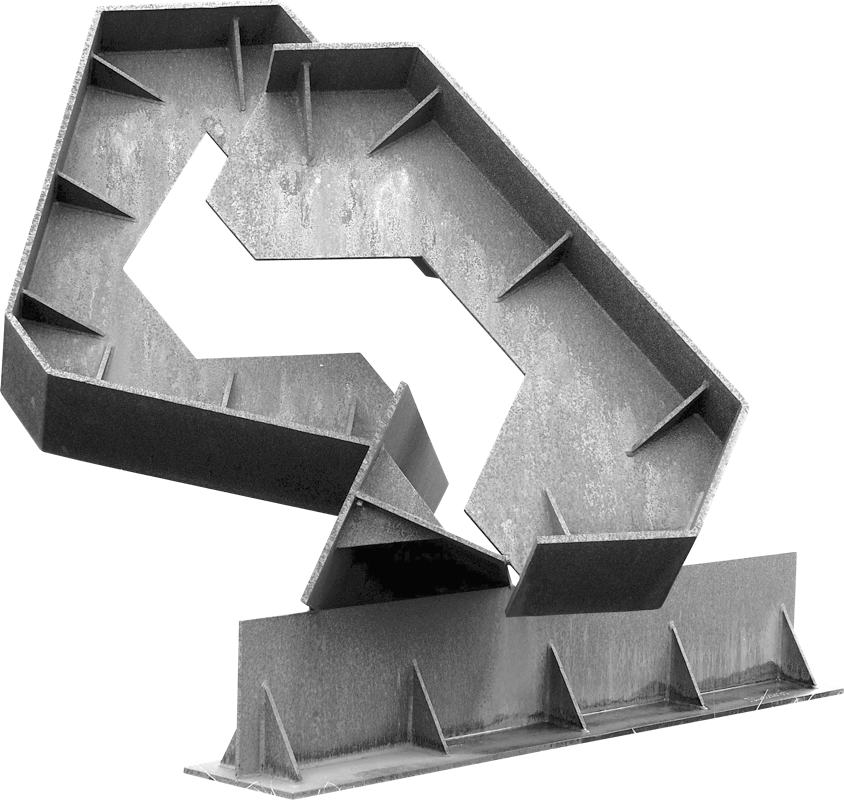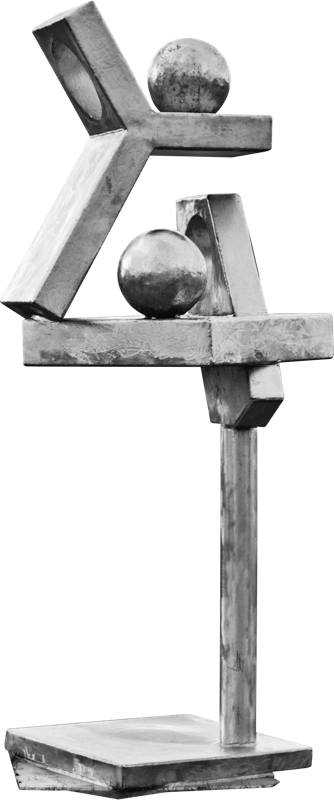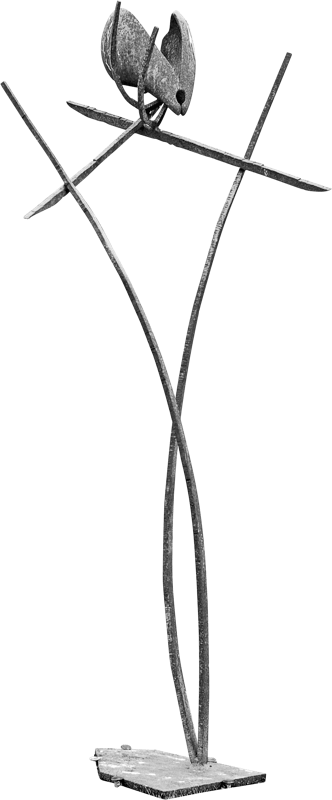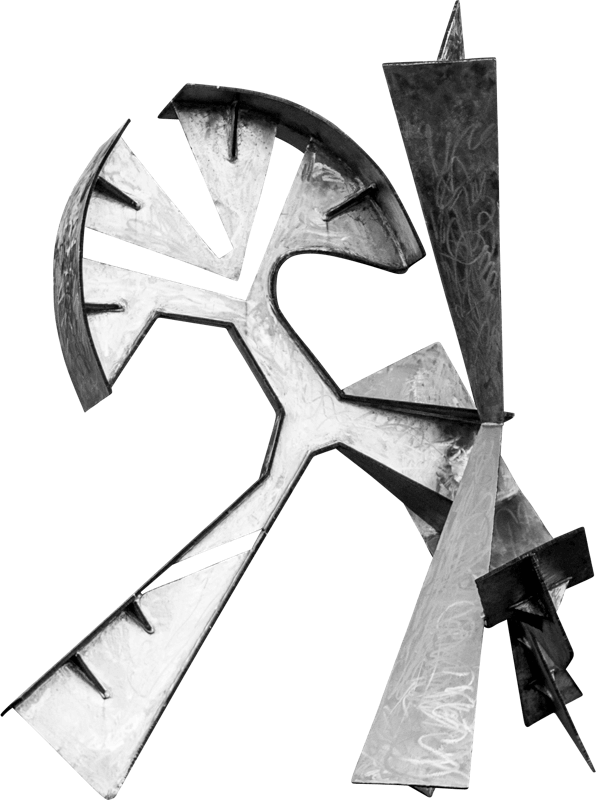Series 3
Rubinoff began his career not as a sculptor but a painter, producing monochrome action paintings inspired by the work of Franz Kline. In this series, Rubinoff revisited those origins, using the planes created by sheets of COR-TEN steel to draw abstract forms in three-dimensional space. As he put it: “To me—after the fact—the volumes of Series 1 became perceived as steel as metaphor for stone. Series 2 reversed this perception by addressing steel in, and of itself… By Series 3, I wanted the steel, not only to aesthetically defy gravity, but to dance. To accomplish this, I returned to the principles of painting—line and plane—and my background in Action Painting. The COR-TEN was the pure manifestation of line and plane in steel, analogous to the black on white strokes of my earlier painting.”
Series 3-1
Jeffrey Rubinoff
1983, A 242 Cor-ten steel – Welded plate, H 5.5ft W 7.5ft L 7.5ft
The opening composition of the series is one of the most deceptively simple sculptures Rubinoff ever made. It consists of just four plates of COR-TEN steel, each of the same dimensions (96 inches long, 16 inches wide, 0.5 inches thick), which ‘bend’ like springs under tension. The piece, which makes only minimal ‘en-pointe’ contact with the ground, acquires its irrepressible sense of uplift through linear means: the four plates create three interlocking lines of increasingly vertical orientations: the base plate is just under 10 degrees from horizontal; the second plate rests atop it at about 20 degrees; and the third and fourth rise up at something closer to 50 degrees.
The opening composition of the series is one of the most deceptively simple sculptures Rubinoff ever made. It consists of just four plates of COR-TEN steel, each of the same dimensions (96 inches long, 16 inches wide, 0.5 inches thick), which ‘bend’ like springs under tension. The piece, which makes only minimal ‘en-pointe’ contact with the ground, acquires its irrepressible sense of uplift through linear means: the four plates create three interlocking lines of increasingly vertical orientations: the base plate is just under 10 degrees from horizontal; the second plate rests atop it at about 20 degrees; and the third and fourth rise up at something closer to 50 degrees.
Series 3-2
Jeffrey Rubinoff
1983, A 242 Cor-ten steel – Welded plate, H 9.5ft W 9.5ft L 8ft
Series 3-2
Jeffrey Rubinoff
1983, A 242 Cor-ten steel – Welded plate, H 9.5ft W 9.5ft L 8ft
Rubinoff here increases the number of plates from four to seven, and also varies their widths: some are 16 inches wide, others 24. Like its predecessor, the bottom half of the work is built from a 10-degree base plate straddled by a tweezer-like form that rises at a steeper angle towards the sky. But Rubinoff also introduced another near vertical plate at the other end of the base that together with its counterpart supports a roof-like lintel. This has the effect of creating a large negative space at the sculpture’s centre, not unlike that created in Series 1-5. The piece thus advances the theme of ascension initiated in 3-1. Where the earlier sculpture captured his material’s first tentative awakenings, here the steel stands emphatically upright.
Series 3-3
Jeffrey Rubinoff
1983, A 242 Cor-ten steel – Welded plate, H 9.5ft W 8ft L 8ft
Rubinoff often reminded visitors that if the welds were to fail his works would literally spring apart. Weighing roughly 600 lb, this is the heaviest sculpture of the series so far, consisting of eight plates – twice the number of Series 3-1. It is an exceptionally complex work that actually reverses many of its predecessors’ principles. While Rubinoff retains the tweezer form that he had used so successfully in the first two pieces of the series, here he turns it quite literally on its head. This time, the pincers rather than the fulcrum point into the air. The reorientation has a dramatic impact on the sculpture’s overall effect: the architectural, post-and-lintel quality of 3:2 is gone, replaced by a set of exploding forms that originate in two different epicentres and travel in opposing directions.
Rubinoff often reminded visitors that if the welds were to fail his works would literally spring apart. Weighing roughly 600 lb, this is the heaviest sculpture of the series so far, consisting of eight plates – twice the number of Series 3-1. It is an exceptionally complex work that actually reverses many of its predecessors’ principles. While Rubinoff retains the tweezer form that he had used so successfully in the first two pieces of the series, here he turns it quite literally on its head. This time, the pincers rather than the fulcrum point into the air. The reorientation has a dramatic impact on the sculpture’s overall effect: the architectural, post-and-lintel quality of 3:2 is gone, replaced by a set of exploding forms that originate in two different epicentres and travel in opposing directions.
Series 3-5
Jeffrey Rubinoff
1983, A 242 Cor-ten steel – Welded plate, H 7ft W 8ft L 8ft
Series 3-5
Jeffrey Rubinoff
1983, A 242 Cor-ten steel – Welded plate, H 7ft W 8ft L 8ft
After completing his fourth piece (the only sculpture of the series not currently held by the Park), Rubinoff turned to its successor. In Series 3-5, he deployed the tweezer-form in both directions for the first time, and so combined elements from all four of his earlier works, producing a small but explosive composition that looks very unlike its predecessors. Rubinoff chose not to repeat the experiment, not because it was a failure but because it represented the necessary resolution of a motif he had exhausted.
Series 3-6
Jeffrey Rubinoff
1983, A 242 Cor-ten steel – Welded plate, H 7.5ft W 9ft L 8ft
This, the sixth piece in the series, is constructed from six plates, which lean against each other like a house of cards. As they do so, these rectangular components create dozens of triangular forms, in both positive and negative spaces that stretch and shift as one walks around them. When Rubinoff resolved to create a sculpture park at his property on Hornby Island, he purchased this piece back from a collector so it could be permanently displayed alongside its counterparts.
Series 3-7
Jeffrey Rubinoff
1983, A 242 Cor-ten steel – Welded plate, H 7.5ft W 10ft L 9ft
Series 3-7
Jeffrey Rubinoff
1983, A 242 Cor-ten steel – Welded plate, H 7.5ft W 10ft L 9ft
In some respects this piece returns to the basic forms of the first work in the series: it too is based on a group of near-horizontal plates that support something closer to vertical, and it too hints at a figure attempting to lift itself off the ground. Here, however, Rubinoff uses a thicker plate (1 inch), and introduces for the first time a motif that would become one of his defining innovations as an artist: the T-section. At the time Rubinoff knew of ‘no artist in the world who had used the T-section successfully’ before this point.
Series 3-8
Jeffrey Rubinoff
1983, A 242 Cor-ten steel – Welded plate, H 8.5ft W 10ft L 8ft
Though it is the penultimate work in the sequence, Rubinoff considered this ‘the apex of the series’, confessing that it was ‘probably what [he] was after the whole way through’. Here the steel genuinely seems to ‘defy gravity’ and ‘dance’. It is a large and heavy sculpture, but it touches the ground only delicately, in just three places. It recycles many of the motifs from earlier in the series: the tweezer-form; the diagonal roof; and the incrementally angled ascending form as used in 3-1. But here the relationship between them, between positive and negative values, between line, plane and volume, is so elegantly balanced that the piece appears as weightless as a series of lines or brushstrokes on a page. ‘That sculpture’, Rubinoff has said, ‘is pure action painting. And it is precisely what I strived for as a painter in the late 1960s’.
Though it is the penultimate work in the sequence, Rubinoff considered this ‘the apex of the series’, confessing that it was ‘probably what [he] was after the whole way through’. Here the steel genuinely seems to ‘defy gravity’ and ‘dance’. It is a large and heavy sculpture, but it touches the ground only delicately, in just three places. It recycles many of the motifs from earlier in the series: the tweezer-form; the diagonal roof; and the incrementally angled ascending form as used in 3-1. But here the relationship between them, between positive and negative values, between line, plane and volume, is so elegantly balanced that the piece appears as weightless as a series of lines or brushstrokes on a page. ‘That sculpture’, Rubinoff has said, ‘is pure action painting. And it is precisely what I strived for as a painter in the late 1960s’.
Series 3-9 1983
Jeffrey Rubinoff
1983, A 242 Cor-ten steel – Welded plate, H 7.5ft W 8ft L 8ft
Series 3-9 1983
Jeffrey Rubinoff
1983, A 242 Cor-ten steel – Welded plate, H 7.5ft W 8ft L 8ft
The last work in the series is the heaviest and most horizontal of the nine sculptures, weighed down by two vast T-beams, one of which is almost parallel with the ground while the other seems to tumble over into the grass. It is so different from what came before that it could even be viewed as presaging the future. Indeed, its robust and stocky forms provided the grammar from which much of the powerful subsequent Series 4 was constructed.























